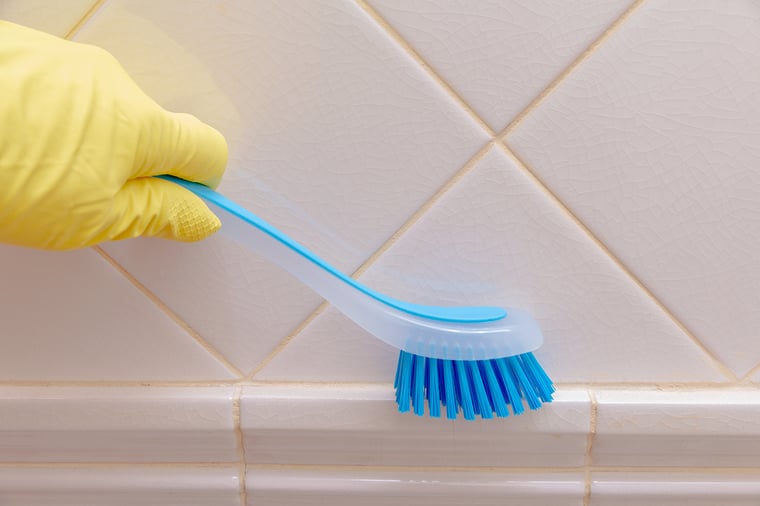
Mildew is a type of fungus that is grayish, whitish or brown in color and thrives in damp areas. It can grow on any surface, from wood to stone. Since moisture encourages the growth of mildew, the bathroom is highly susceptible and may grow on bathroom fabrics like curtains, mats and even the bathroom ceiling and insulation. Here are some home maintenance tips for how to prevent mildew in your bathroom and the dangers it can cause:
What Are the Dangers of Mildew in a Bathroom?
While mildew is important to the environment by helping breakdown organic materials, it can be a nuisance when it invades your bathroom. Pregnant women, the elderly, children, asthmatic individuals, and people with lung diseases and compromised immunity are at a greater risk of suffering complications from inhaling mildew spores. Some of the dangers associated with bathroom mildew include:
- Fungal infections in the lungs: For people with lung diseases, mildew spores can cause lung infections.
- Skin irritation: For people with sensitive skin, touching mold may lead to very itchy skin rashes that are red in color.
- Allergies and respiratory problems: If you suffer from allergies, inhaling mildew spores could trigger hay fever and cause red eyes, sneezing and sinus pressure. Mildew can also trigger an attack if you suffer from asthma.
- Property damage: Mildew eats into structures and surfaces, causing rot and weakening walls and ceilings. This reduces the structural integrity of the wooden parts of your bathroom and lowers the overall value of your home.
- Decreased visual appeal and a foul smell: The gray and brown patches of mildew in your bathroom can be an eyesore. The fungi may also produce foul smell giving your bathroom a bad odor.
5 Expert Home Maintenance Tips to keep Mildew Away from Your Bathroom
Mildew takes as little as 24 – 48 hours to develop and has spores that rapidly travel through the air, making it sometimes hard to control, especially if you live in a cold area. However, there are steps you can take as part of your home maintenance practices to prevent mildew from growing in your bathroom. Here are 5 tips to keep your bathroom free from mildew and safeguard the health of your family, as well as the integrity and quality of your home:
1. Use Mildew-resistant Paint & Shower Curtains
Mildew-resistant paint is made specifically with anti-microbial additives that thwart the growth and spread of mildew by killing the spores before they can grow. It also prevents odors caused by bacteria and water and obstructs water from seeping into your walls. As such, painting your bathroom’s walls and ceiling using mildew-resistant paint can help you keep your bathroom free from this biological growth.
Additionally, mildew-proof shower curtains contain anti-microbial treatments that inhibit the growth of mildew on the fabric, thus, reducing spores count in your bathroom.
If you are thinking about painting your bathroom as your next home maintenance project, make sure you clean it first with a mixture of 3 parts bleach and 1 part water to remove any previous mildew. This is because painting over mildew will not get rid of the problem, as it will grow right through the paint. Mildew-resistant paints are readily available in the market and can last for more than 4 years.
2. Improve Ventilation
A poorly ventilated bathroom, coupled with moisture, provides optimal conditions for mildew to grow and spread. It is, therefore, mandatory that you install proper ventilation if you want to prevent mildew in your bathroom. Promoting air circulation helps carry warm air to colder areas of your bathroom and reduces the build-up of fungus spores and humidity. You can boost your bathroom’s ventilation by installing a fan and vents in your bathroom. When showering, keep the windows open if you can and be sure to turn the fan on. Make sure to leave the fan on for 30 minutes after you are done to help eliminate moisture.
Keep in mind that channeling bathroom vents to the attic can worsen the problem, as it causes moisture to be trapped in the attic, leading to accelerated mildew and mold growth in the attic’s insulation, ducts and wood. For this reason, it is important to ensure that the vents are insulated, go directly out of the roof through the attic and are as short as possible. Always check that your vents are clean, free of blockages and working as expected when you perform your regular home maintenance tasks.
Some signs of poor ventilation in the bathroom include:
- High Humidity
- Mildew
- Peeling Paint
- Frosty Windows
- Wall and Ceiling Stains
You can also use mold air filters in your ventilation systems to filter out spores and prevent them from spreading to the rest of the home.
3. Keep the Bathroom as Dry as Possible and Let Light In
Another way of preventing mildew is ensuring there’s as little moisture in your bathroom as possible. This requires you to mop the water off both on the floor and bathtub after use. Also, check for any leakages from the sinks, toilet and bathroom pipes and have them fixed so that the bathroom remains dry when not in use. If there is too much humidity, you can also invest in a portable dehumidifier to keep moisture levels at a minimum.
Since mildew and mold love darkness, ensure that adequate light gets into your bathroom. You can achieve this by always keeping the bathroom windows open and leaving the bathroom lights on periodically.
4. Keep the Bathroom Clean
Dirt forms a good platform for mildew to grow and feed on. Be sure to regularly clean all your items ranging from towels and mats to the bottom of shampoo bottles to keep off the dirt. You should also change your loofah often, as it has many crevices for mildew to hide in. Regular cleaning of your bathroom will help you prevent mildew growth in the long run. It is advisable to use bleach and water or antifungal solutions for the best results.
5. Seal and Replace Grout
The grout on your bathroom tiles is highly porous, which is ideal for mildew growth. What’s more, they tend to crack over time, which enables them to let in spores, germs and stains. To prevent water from seeping into the grout and encouraging mildew and mold growth, you should seal grout at least once a year. Applying sealants is also important to make grout stain-proof, more visually appealing, long-lasting, and also prevent germs, bacteria as well as mold spores from getting in.
If the grout in your bathroom is cracked or stained, you may need to have it replaced. The good thing is that you can do it yourself as part of your home maintenance routine. You only need to remove old grout, clean out the seams, mix the tile grout and apply it in the seams. When you are done, clean the excess grout and polish the tiles for a fresher and shinier look.
Home maintenance is essential for safeguarding the health and comfort of your loved ones and keeping your home in good condition. By practicing the above home maintenance tips, you can keep your bathroom free from mildew and mold. For more expert tips to help you keep your home well-maintained, give these articles a read:

















